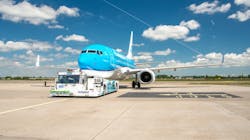Towing Technology’s Journey to North America
Having seen positive results from operations in India and Europe, officials are working to implement sustainable aircraft towing technology in North America by introducing the TaxiBot, a semi-robotic towing vehicle, at locations across Canada.
With the experience of already launching the equipment in India and initially supporting TaxiBot operations in Amsterdam, AeroTech Support Services and its subsidiary Alternate Aeroworks Canada have identified Montreal, Toronto, Vancouver, Edmonton and Calgary as airports that could utilize TaxiBot due to longer taxiing times and their number of flight operations.
TaxiBot is controlled by the pilot of the aircraft as the tractor tows the plane from the terminal to the runway. Because this is done without the use of the aircraft’s engines, a significant amount of jet fuel is preserved. Powered by a hybrid of electric and diesel engines, TaxiBot provides additional green benefits.
By deploying 26 TaxiBot units across these five Canadian airports, company officials say 650 TaxiBot operations could be carried out on a daily basis. According to Ashwani Khanna, director at Alternate Aeroworks Canada, this would help save approximately 200,000 tons of carbon dioxide (CO2) on an annual basis.
“Presently, we have signed a MOU with Montreal, have conducted a survey at Vancouver Airport and are in talks with Edmonton Airport,” explains Khanna. “We are aligning various resources and closure of MOUs and are planning to launch the project starting October to November of this year.”
Alternate Aeroworks Canada has an exclusivity to own and operate the TaxiBot in Canada. TaxiBot was designed by Israel Aerospace Industries (IAI), is manufactured by TLD and is powered by technology developed by TLD’s sister company Smart Airport Systems (SAS). AeroTech Support Systems, the parent company of Alternate Aeroworks Canada, would also assist Canadian operations by setting up procedures at each airport and providing training for TaxiBot operations.
Earlier this year, a stakeholders meeting was held in Montreal to explore the viability of TaxiBot at the airport. The meeting, which was organized by the airport authority, was attended by representatives from airlines and service providers. Additionally, a case study has been conducted at Vancouver.
From these initial trials, Khanna says Alternate Aeroworks Canada proposed an option to use TaxiBot to decongest the apron area.
“A plan has been discussed in detail that when we start Montreal, the airport would like to see the decongestion benefit arriving from the use of the TaxiBot,” Khanna says. “The logic was that after pushback and engine start, there is a lapse of about six minutes. This may impact other aircraft movements, especially in the cul-de-sac area.
“With the use of the TaxiBot, as there is no engine start, the holding time is reduced to about two minutes,” he continues. “This is where the savings come for the airline and airport.”
In addition to reduced CO2 emissions and reduced ground times, Khanna says additional benefits for airports and airlines include reduced cost, reduced jet blast damages issues, reduced FOD and brake wear, and reduced wear and tear of jet engines, among others.
Airports in North America have a greater potential for efficiency gains than airports in India, Khanna says, noting more traffic and other factors like deicing requirements can add to taxiing times.
“Each airport is different and the procedures have to be made while keeping operational constraints of that airport,” Khanna says.
The Canadian aviation system stands to benefit from the use of TaxiBot, Khanna says, especially ground handlers with a vision to support sustainable aviation practices.
About the Author
Josh Smith
Editor
Josh Smith served as editor of Ground Support Worldwide as editor from 2016 through 2024. He oversaw production of the print magazine, created GSW's newsletters on a daily basis, and updated the latest news on AviationPros.com.

